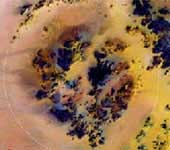Scientists have discovered a previously unseen large crater in the Sahara Desert. The crater spans approximately 31 kilometers in diameter, making it twice the size of the largest crater previously identified in the region.
 |
The Kebira Crater located in Western Egypt has a radius of approximately 31 km. |
The newly discovered crater may have formed from the impact of a meteorite about 1 kilometer wide crashing into the ground, destroying everything within hundreds of kilometers.
Scientists from Boston University, Farouk El-Baz and Eman Ghoneim, discovered this crater and named it Kebira.
Kebira means “large” in Arabic and is closely related to the name of the Gilf Kebir area in Egypt, where the giant crater was found.
El-Baz stated, “Kebira covers an area equivalent to 125 football fields or the entire area of Cairo from the northeast airport to the pyramids in the southwest. When studying similar craters, we focus on small features that can be identified on the ground. Satellite images provide us with a broader perspective.”
Typically, impact craters have a circular rim shape. However, they can be eroded by water and wind, making them less likely to be detected by the naked eye.
Ghoneim noted that there were two ancient rivers that once flowed through the Kebira Crater from the east and west.
T. Nam




















































